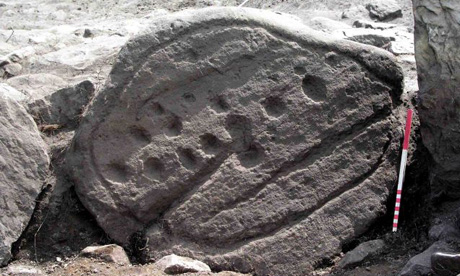YORKSHIRE ARCHAEOLOGY VISIBLE FROM FIRES

Carved stones found on Fylingdales Moor in North Yorkshire
A catastrophic fire which "skinned" a precious moorland to its rocky bones has unexpectedly revealed some of the most important prehistoric archaeology found in Britain. The uncontrolled six-day blaze on Fylingdales Moor in North Yorkshire has exposed a lost landscape dating back 3,000 years which is now to be made accessible to the public by English Heritage.
Unique rock art and unprecedentedly clear bronze age field boundaries have emerged from the soot and cinders which were all that was left of two-and-a-half square miles of the North York Moors national park when fire crews and heavy rain finally swamped the area in September 2003. The intense heat destroyed the entire blanket of peat which had accumulated over the area, close to the North Sea coast, since farmers abandoned it for unknown reasons in around 1000BC.
"We have always known that this part of the world is very rich in prehistoric remains," said Graham Lee, senior archaeological conservation officer for the national park. "But the sheer number of new finds exposed by the fire is the most exciting development in archaeology in my experience." The rock art list for the site, part of a vast moor also used by the RAF's Fylingdales satellite tracking and early warning station, has grown to almost three times its previous size, with more than 100 sets of mysterious lines, cups and circles discovered since the fire.
"One of the very rare features exposed by the removal of the entire plant and soil covering is a set of defined borders to the areas cultivated in the bronze age," said Lee.The North York Moors form one of Britain's most important prehistoric sites, with the wild, rolling uplands the equivalent of Leeds or Manchester in their day. In contrast to most of the rest of the country, their population had its heyday in the second century BC, and has since dwindled to today's scattering of neat villages which largely depend on tourism.
"The fire was environmentally disastrous," said Lee, whose colleagues joined landowners after the fire in reseeding the heather. "But it gave us access to a landscape which we could never have reached otherwise, on such a scale. No archaeologist has the means to dig out an area like this. What we have found as a result has altered perceptions of the period. It also raises questions about the scale of what else lies hidden over the rest of the North York Moors."
Finds include stone age flint tools and drainage runnels and trackways from the 18th century alum industry, which used shiploads of urine from London to break down shale and produce the chemical for dyes and other ground-breaking uses in the Industrial Revolution.
The wealth of the Fylingdales finds will now be collated with a £26,000 publication grant from English Heritage, following a local exhibition of the principal discoveries. "Everyone had to work very rapidly, because the protective cover had vanished," said Lee. English Heritage's project officer for Fylingdales, David Went, said the fire had "opened up a whole new chapter in our understanding of the moor".
- Martin Wainwright The Guardian,
- Thursday August 21 2008


0 Comments:
Post a Comment
<< Home